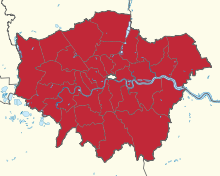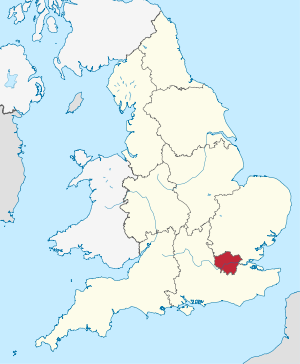Greater London
| Greater London county | |
|---|---|
|
|
|
| Country | United Kingdom |
| Part of the country | England |
| region | Greater London |
|
|
|
| status | Region and Ceremonial County |
|
|
|
| Ceremonial county | |
| surface | 1,569 km² (25th of 48 ) |
| Residents | 8,817,300 |
| was standing | 2017 (estimate) |
|
|
|
| region | |
| founded | April 1, 1965 |
| out | County of London and parts of Middlesex , Essex , Kent , Surrey and Hertfordshire |
| by | London Government Act 1963 |
| Administrative authority | Greater London Authority |
| Administrative headquarters | Southwark |
| surface | 1,572 km² |
| ONS code | H |
| GSS code | E12000007 |
| NUTS code | UKI |
| Website | www.london.gov.uk |
|
|
|
|
structure
( Inner London and Outer London ) |
|
The administrative area Greater London ( English for Great London ), in the NUTS headings from Inner and Outer London called, is one of nine regions in England and, in addition to the unique in its status central district City of London 32 London boroughs , including the central borough of City of Westminster . Although Greater London is the only region of England that still has a unified administration, it is not a city, but a region in which cities and towns are located. Statistically it is broken down into Inner London and Outer London .
The 32 boroughs also form the administratively insignificant ceremonial county of Greater London , while the City of London is its own ceremonial county; Administrative counties there is no different than in other regions of England.
The area is 1572 km² and in 2012 Greater London had 8,308,369 inhabitants. Since 2000, Greater London has been administered by the Greater London Authority and ruled by the directly elected Mayor of London (Lord Mayor). Since 2016 this has been Sadiq Khan . The London Assembly forms the legislature .
history

Greater London was formed in 1965 when the City of London , County of London , County of Middlesex and parts of Counties of Essex , Kent , Surrey and Hertfordshire were merged. Greater London thus comprised all built-up areas within the green belt .
Greater London initially had a two-tier form of administration. On the first level were the Greater London Council (GLC) and the Corporation of London (responsible for the City of London), including the 32 boroughs. The GLC was repealed in 1986 by Prime Minister Margaret Thatcher . Some functions were delegated to the corporation and the 32 boroughs, and others directly to the central government.
In 2000 the Labor government under Tony Blair created the Greater London Authority as part of an administrative reform , consisting of the London Assembly and the office of Mayor of London . Since then, Greater London has had a single administration again. The 2000 and 2004 mayoral elections were both won by Ken Livingstone , the last chairman of the GLC. He was replaced in the 2008 elections by Boris Johnson from the Conservative Party , who was confirmed in office in 2012. In 2016, Sadiq Khan (Labor) was elected. In the London Assembly, the Conservatives were the strongest party until the 2012 election; from 2000 to 2004 the Labor Party held the same number of seats, but received slightly fewer votes. Labor has been the strongest political group since 2012.
Map of the London Boroughs and the City of London
| The London boroughs: | ||
|
Residents in brackets ( as of UK Census, 2001 ) |
|
economy
In comparison with the GDP of the EU, expressed in purchasing power standards, the region achieved an index of 184 (EU-28 = 100) (2015).
See also
Individual evidence
- ↑ Population of England and Wales on June 30, 2012 ( ZIP ; 832 kB)
- ↑ Eurostat. Retrieved August 22, 2018 .
Coordinates: 51 ° 30 ′ N , 0 ° 7 ′ W




